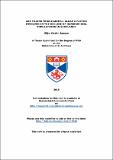Files in this item
Are toxins from harmful algae a factor involved in the decline of harbour seal populations in Scotland?
Item metadata
| dc.contributor.advisor | Hall, Ailsa Jane | |
| dc.contributor.author | Jensen, Silje-Kristin | |
| dc.coverage.spatial | viii, 231 p. | en_US |
| dc.date.accessioned | 2015-07-27T13:50:12Z | |
| dc.date.available | 2015-07-27T13:50:12Z | |
| dc.date.issued | 2015 | |
| dc.identifier.uri | https://hdl.handle.net/10023/7035 | |
| dc.description.abstract | Firstly this study builds on the investigation initiated by Hall and Frame (2010), which found that Scottish harbour seals were exposed to domoic acid (DA), a potent natural neurotoxin produced by phytoplankton. Using the same sample collection technique to gather urine and faecal material from various populations around Scotland with differing population trajectories (Lonergan et al., 2007), the objective was to investigate not only exposure to DA, but also other groups of toxins such as paralytic shellfish poisoning (PSP) toxins and the lipophilic toxins okadaic acid (OA) and dinophysis toxins (DTXs). Toxins from harmful algae are thought to be potential causative factors in the ongoing harbour seal decline in some regions of Scotland (Hall and Frame, 2010). This investigation was initiated because Pseudo-nitzschia (which produces DA) in particular was found to be highly prevalent in the phytoplankton communities in Scotland (Fehling et al., 2004; Stobo et al., 2008) and indeed was first observed at increased concentrations at around the time the harbour seal populations were observed as declining (Lonergan et al., 2007; Stobo et al., 2008). Prior to 2000 harbour seal populations in Scotland were largely stable or increasing. In addition DA exposure has had a devastating effect on the California sea lions (CSL) from the US west coast, where morbidity and mass mortality has occurred as a result of exposure (Goldstein et al., 2008; Gulland et al., 2002; Lefebvre et al., 1999; Scholin et al., 2000). In addition to the toxin analysis in urine and faecal samples, blood samples were collected and health parameters such as white blood cell and differential cell counts were investigated. Plasma cortisol concentrations and parasite faecal egg counts were additionally investigated as parameters indicative of adrenal function and parasite burden. CSL exposed to DA have significantly lower blood cortisol levels and higher eosinophil counts (Gulland et al., 2012) so it was possible that these indicators of effects might also be seen in the harbour seals. High parasite loads are often associated with high eosinophil levels (Klion and Nutman, 2004) so these data were needed to ensure any positive relationships found were linked to DA and were not a consequence of parasite burdens. The work presented in this thesis highlights the effect of exposure to the neurotoxin DA and documents that Scottish harbour seals are exposed to multiple toxins such as PSP toxins, OA and DTX-2 (Chapter 2, Chapter 4). Immunomodulatory effects of DA exposure such as lymphocytopenia and monocytosis are also reported. In general, harbour seals from the east coast and Northern Isles, where the decline in abundance has been greatest, had higher levels of DA in their excreta than animals from the west coast. The concentrations in the faeces and urine samples were generally low but time since exposure was unknown. Uptake of DA, PSP toxins, OA and DTXs in randomly selected fish from the east coast of Scotland in the Firth of Forth was investigated (Chapter 3), where benthic, flat and pelagic fish are shown to be vectors of toxin transfer and emphasis is drawn to flatfish as they seem to accumulate higher levels of toxins than the other species analysed. This indicates that harbour seals foraging off the east coast are likely to regularly encounter toxic prey that could impair their health. In addition to live captured harbour seals, samples from dead stranded marine mammals (including cetaceans and in particular harbour porpoise) found a range of species in Scottish waters were exposed to both DA and PSP toxins (Chapter 4). A monitoring tool to rapidly determine chronic DA exposure in blood samples was published recently for DA exposed CSLs and in Chapter 5 this monitoring technique was attempted in phocid seals, and where it failed to be replicated or validated which questions its function as a DA monitoring tool. Questions regarding how quickly a marine mammal excretes DA from the body have been discussed in the literature and in Chapter 6 an experiment was set up to measure the clearance of DA by using a biomarker (Iohexol). Iohexol was successfully measured in plasma samples from captive harbour seals following oral intake, where concentration and time of the iohexol peak was identified together with the calculation of its half-life. These results indicate the approximate elimination rate of DA (and potentially other hydrophilic toxins) and can be used to better interpret urine levels of DA measured in wild caught harbour seals. Collectively the results of this research will enable the risk posed by the ingestion of various toxins present in the Scottish marine food chain to marine mammals (particularly harbour seals but also harbour porpoise and grey seals) to be assessed. | en_US |
| dc.language.iso | en | en_US |
| dc.publisher | University of St Andrews | |
| dc.subject.lcc | QL737.P64J4 | |
| dc.subject.lcsh | Harbor seal--Scotland | en_US |
| dc.subject.lcsh | Seal populations--Scotland | en_US |
| dc.subject.lcsh | Toxic marine algae--Scotland | en_US |
| dc.title | Are toxins from harmful algae a factor involved in the decline of harbour seal populations in Scotland? | en_US |
| dc.type | Thesis | en_US |
| dc.contributor.sponsor | Marine Alliance for Science and Technology for Scotland (MASTS) | en_US |
| dc.type.qualificationlevel | Doctoral | en_US |
| dc.type.qualificationname | PhD Doctor of Philosophy | en_US |
| dc.publisher.institution | The University of St Andrews | en_US |
This item appears in the following Collection(s)
Items in the St Andrews Research Repository are protected by copyright, with all rights reserved, unless otherwise indicated.

